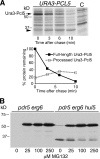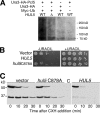The ubiquitin ligase Hul5 promotes proteasomal processivity
- PMID: 20008553
- PMCID: PMC2815575
- DOI: 10.1128/MCB.00909-09
The ubiquitin ligase Hul5 promotes proteasomal processivity
Abstract
The 26S proteasome is a large cytoplasmic protease that degrades polyubiquitinated proteins to short peptides in a processive manner. The proteasome 19S regulatory subcomplex tethers the target protein via its polyubiquitin adduct and unfolds the target polypeptide, which is then threaded into the proteolytic site-containing 20S subcomplex. Hul5 is a 19S subcomplex-associated ubiquitin ligase that elongates ubiquitin chains on proteasome-bound substrates. We isolated hul5 Delta as a mutation with which fusions of an unstable cyclin to stable reporter proteins accumulate as partially processed products. These products appear transiently in the wild type but are strongly stabilized in 19S ATPase mutants and in the hul5 Delta mutant, supporting a role for the ATPase subunits in the unfolding of proteasome substrates before insertion into the catalytic cavity and suggesting a role for Hul5 in the processive degradation of proteins that are stalled on the proteasome.
Figures








References
-
- Chernova, T. A., K. D. Allen, L. M. Wesoloski, J. R. Shanks, Y. O. Chernoff, and K. D. Wilkinson. 2003. Pleiotropic effects of Ubp6 loss on drug sensitivities and yeast prion are due to depletion of the free ubiquitin pool. J. Biol. Chem. 278:52102-52115. - PubMed
-
- Crosas, B., J. Hanna, D. S. Kirkpatrick, D. P. Zhang, Y. Tone, N. A. Hathaway, C. Buecker, D. S. Leggett, M. Schmidt, R. W. King, S. P. Gygi, and D. Finley. 2006. Ubiquitin chains are remodeled at the proteasome by opposing ubiquitin ligase and deubiquitinating activities. Cell 127:1401-1413. - PubMed
-
- Ellison, M. J., and M. Hochstrasser. 1991. Epitope-tagged ubiquitin. A new probe for analyzing ubiquitin function. J. Biol. Chem. 266:21150-21157. - PubMed
Publication types
MeSH terms
Substances
LinkOut - more resources
Full Text Sources
Molecular Biology Databases
